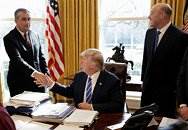By now, we’ve all seen, or at least heard, about Intel CEO’s Brian Kraznich Fab 42 announcement (done from the Oval Office, no less). It was to be a joint press conference to announce a highly impactful investment on U.S. soil, which also turned into some welcome PR for Intel, and got the CEO some face time with the President.
It has to be said though, that hailing this as a Trump administration win is simply politics doing its best: spinning the truth for its own benefit. I say this because the original announcement for the construction of this Arizona fab was done way back in 2011, with then Intel CEO Paul Otellini breaking the news that they would spend $5 billion on the plant during the Obama Administration. Construction started that year, with overall expectation for its completion being somewhere around 2013. Cue the usual delays, and enter 2013’s 10% decline of the PC market, and Intel did what any sensible company would do in the wake of lower expected volume of shipments (and respectively lower production needs) – they postponed the opening of the factory, indefinitely, instead choosing to improve manufacturing capability of its then already-operational fabs. So, the factory wasn’t announced because of President Trump’s policies and overall government acumen, nor is it probably going to be finished by the time his first term ends.
Krzanich didn’t make this announcement because the “tax and regulatory policies” of the Trump administration are “advantageous”. Kraznich did it in a show of force and open support for President Trump (as Kraznich has a past of doing), and if there’s one thing we know of Intel (and every other major corporation focused on profit) is that everything happens for the bottom-line. The question of “why now” isn’t answered with “because of President Trump’s policies”. It’s answered by Krzanich’s internal memo to Intel employees: because growing demand means Intel must increase production capacity. A sign of the times is the fact that the Arizona fab was originally projected to push Intel’s 14 nm manufacturing capability, but has now been re-purposed as an accelerator towards Intel’s 7 nm aspirations.
Although it has to be said, as President Trump himself would, that Arizona workers will be very happy: 10,000 jobs is a whole big number – full of zeroes. Arizona is second only to Nevada in overall population growth rate, and job creation is one of the most important economic growth factors. Though that’s not the real number of workers: that’s the best-case scenario. The real number of direct jobs to be created by this investment is around 3,000, with up to 10,000 jobs being created “in support” of the factory, as Kraznich himself put it (such as new businesses opening to support the infrastructure and the increased number of employed workers).
In fact, President Trump’s administration hasn’t even made a concrete, thought-out move towards tax breaks on American companies, though he did promise a 15% reduction in taxes while campaigning. So far, the only thing they’ve done on that camp is freezing new and outstanding regulations to fall into place, as well as adopting a purely “less is better” approach to tax regulation: for every new tax regulation, cut two previously existing ones”.
Now personally, I find it to be extremely disconcerting that President Trump’s administration has the most clearly-defined trend of donations having bought top spots in the Trump administration, in what can be called influence peddling, even avoiding such boresome proceedings as ethic reviews for conflicts of interest.
All in all, I just think these are way too many coincidences to be just that. It seems simply as just yet another pivot, another case of one hand washes the other in the cutthroat world of corporate interests and political favor, of chess played (and paid) with billions. Let’s face the proverbial elephant in the oval office: Intel’s announcement is a complete farce, being indicative of an unhealthy balance of powers between those that be at the White House and corporate interests.
I understand how negative all of this sounds. But every case must be considered as-is, and this one simply isn’t. There are healthy, transparent, strengthening bonds that a government can have with the corporations that are the lifeblood of its economic development, which positively impact the every-man’s life. Tax cuts may be one of them, by increasing the amount of leeway a company can have on its own internal investment, R&D, increased employment and better conditions for its workforce. Government subsidies, which propel promising startups which then grow on to provide new, competitive businesses and thus reinforce the economy – of which Intel has received at least $5.9 billion dollars itself, from tax rebates to federal grants, including almost $100 million in property tax immunities (while AMD itself has received only about $11 million). Another good example is how governments supported what were, at their infancy, extremely low-margin business (like the solar panel and renewable energies companies), eventually ushering us all into developments that will only improve the quality of life for us and our children.
There are ways of doing things; both President Trump and Kraznich may even know how to do them, and have certainly done some of them before.
But then, then there are ways of how not to do things.






